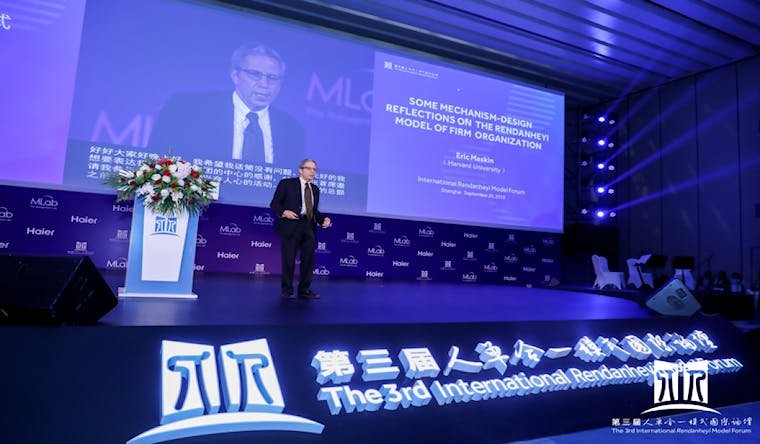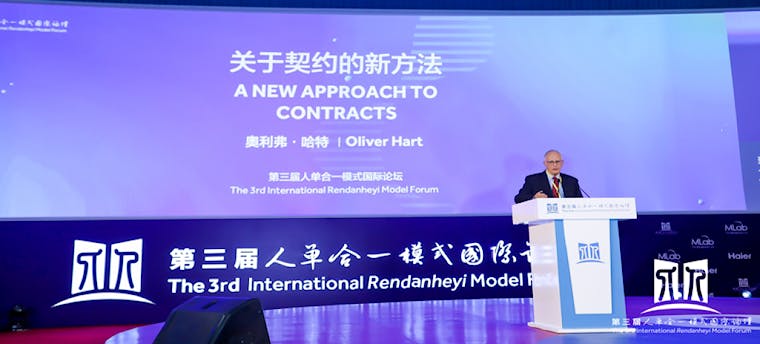The Corporate Rebels In Oslo, Stockholm, And Amsterdam

In a previous post on Haier's RenDanHeYi forum in Shanghai we shared which speakers we were looking forward to, hoping they would provide “Management Fireworks”. Last year we were hosting the forum, but this year we could sit back and listen. Now it’s time to share with you. So, strap in and enjoy!

What the hell is Haier’s RENDANHEYI model Forum?
Haier has organized this event (named after their unique management model) for three years. Each year it grows, and even more prestigious guests are invited. This was the first time that the event was in Shanghai, and not Qingdao (the home of Haier). Shanghai is a city of 24 million people(!)and more internationally oriented, which fits perfectly with Haier’s ambitions to be better known globally: and not just for their appliances, but also for their unique organization model.
Among this year’s guests were academics, managers, thought leaders, and a couple of rebels! Add the keynote speakers, including Nobel laureates who talked about the core dynamics that can be found within Haier and you’ve got yourself a really interesting event.
The Forum’s theme
This year’s theme was built around the “Ecosystem Micro-Community (EMC)” and the “RenDanHeYi Smart Contract”. How these work in detail we will describe in another post. For now, we’ll focus on the things we learned from the keynote speakers and how those theories inspired Haier’s management model.
Eric Maskin, Nobel Prize Winner in Economics (2007)

Eric was the first speaker. He won the Nobel prize for his part in developing the Mechanism Design Theory, which provides a framework for collective decision making. His talk focused on a problem of bureaucracy and, specifically, how to reward someone for their work.
He explained that in a small organization, with one boss, she can still observe how employees perform. Therefore she can judge if they do their job well, and thus how much they should earn. As an organization grows, that becomes impossible. They hire middle managers, who increase the distance between top-management and the people actually creating products. That leads to big gaps between what employees can do and what customers want. In turn, this forces employees to work their arse off for targets they don’t believe in, that doesn’t help the company innovate or earn in an efficient way and, sometimes, it simply doesn’t help the customer.
Maskin gave insight into how to make sure that doesn’t happen. He explained that if producing teams can sell products directly to their customers, and receive benefits from that, they will be encouraged to innovate and make products the consumer needs. If they do, they benefit directly from methods for saving time or money.
So why have top-management at all? “Well”, Maskin argued, “although new technology has eliminated many problems of the economies of scale, the brand still remains. Top-management should be responsible for quality control and ensuring trust in the brand”.
As you can imagine, we acknowledge the problems of bureaucracy that Maskin described. His explanation of how those problems lead to organizations being less efficient, less engaged, and less innovative were spot on. We could name lots of organizations where you can see this happening. Does your company have these problems as well?
Key takeaways
Maybe it’s not a new insight, but it is worth sharing again: setting targets top-down that don’t align with reality damage your customers, your business and, most of all, your employees.
Oliver Hart, joint Nobel Prize winner in Economics (2016)

Hart explained the concept of “Shading” that occurs when contracts are not focused on creating a scenario beneficial to both parties. “Shading happens when a party isn’t getting the outcome it expected from the deal and feels the other party is to blame or has not acted reasonably to mitigate the losses. The aggrieved party often cuts back on performance in subtle ways, sometimes even unconsciously, to compensate.”
For example; A supplier has a deal with a factory to deliver a product for a certain price over a fixed period. But then a trade war between China and the U.S. or Brexit happens, and the supplier cannot deliver the goods for the price they agreed. The factory can still demand the goods, but most likely the supplier will start to under-perform and cut corners where they can to avoid losing any more money. The result? Angry supplier, plus angry user who has received lower quality products. A Lose-Lose scenario.
Key takeaways
Hart shared a 5 step method to address these problems, by looking at contracts from a “What’s in it for we?” perspective.
- Step 1: Lay foundation for a partnership mentality
- Step 2: Co-create a shared vision and objectives
- Step 3: Adopt guiding Principles based upon 6 key ones; Reciprocity, Autonomy, Honesty, Loyalty, Equity and Integrity.
- Step 4: Align expectations and interests
- Step 5: Stay Aligned
Bengt Holmström, shared Nobel Prize winners in Economics (2016)

Holmström focused on the problem of designing incentives for multiple tasks. Designing those incentives becomes challenging when easy-to-measure tasks compete with harder-to-measure tasks, for example the number of coffees you make and the quality of those coffees, as perceived by the customer.
Holmström argues there are multiple ways to solve this problem. The first is to pay more money for the hard-to-measure tasks, another solution is to provide low powered incentives in general. “No incentive may be the best incentive, even for tasks that can be perfectly measured. History teaches us that targets and incentives aren’t always a good combination, and can lead to giant scandals. Just think about the BP oil spill, or teachers manipulating test results because the school receives funding based on the average grade of their pupils.”
Key takeaways
Designing incentives for multiple (hard to measure) tasks can be challenging and lead to unwanted results. If you want to use incentives, make sure you look at all the work the person is doing, instead of just a predetermined target. And don’t forget to think about the potential negatives of setting targets, because they can be huge!
W. Brian Arthur, Pioneer in the science of complexity theory

Arthur started his keynote with a mesmerizing video to explain the core of complexity theory: “Complicated behaviour can be caused by relatively simple individual patterns”. It shows thousands of starlings doing the same thing: staying as close as possible to those around them, resulting in complex figures.
Arthur argued that the same logic applies to economics. “Individual actors react to economic situations created by others. This changes the situation, causing other actors to change their strategies again”. This creates a world in which individuals, banks, companies and investors are always adapting to the situation around them. It’s a world where “Adaptive strategies and actions are constantly being ‘tested’ for survival.”
Complexity economics sees the economy as an ecology. A system in which the behaviour of any individual (actor) influences that of the others within the system. It is similar to that of an ecosystem in nature, where the extinction of a small species like the bee could eventually lead to problems for other species, even humans
To survive in an economic ecology, individual actors need to keep evolving their strategies and ways of organizing. Any organization that can do that quicker and more efficiently than others, will have a giant competitive edge.
Key takeaways
In order to survive, individuals and organizations need to keep evolving and adapting their strategies to their changing (economical) context. Organizations incapable of changing quickly enough, will cease to exist.
Aren’t we missing someone?
You’re right! Zhang Ruimin, Haier’s CEO is missing. In his keynote, Zhang gave a sneak preview of Haier’s ambition to further evolve by creating ecosystems of small Micro-Enterprises that are organized around their users. That preview was really interesting, and rather complex. We’ve decided to dedicate our next Haier blog to this, so that we can provide more context.
Did the forum provide us with the fireworks we expected?
Yes it did. The third RenDanHeYi model forum was very interesting. You could see clearly that Haier is improving the format every year. The speakers were stimulating, and the theories they shared insightful.
In our next blog we will share what CEO Zhang Ruimin had to say, and explain how Haier uses these theories as a basis for their organization model.
FYI; This blog is part of a series and is the result of a research collaboration between Haier & Corporate Rebels. Want to know more?
- Find all our related blogs here!
- Want to stay up to date about the Haier Book ? Subscribe here!
- If you're interested on conducting a site visit so you conduct your own research, make sure to reach out to Ellen@corporate-rebels.com

